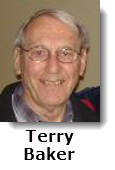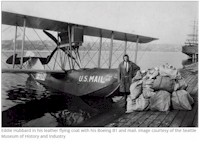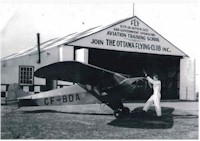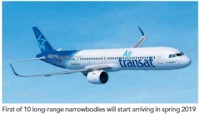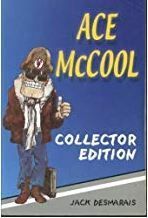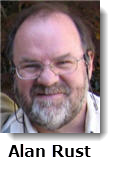 Bent Props and Blowpots
Bent Props and Blowpots
As you hopefully noted above, we've lost a few more of our aviation "heroes." Although it's always sad to hear of their passing, they lived an exciting and interesting life and lived to a ripe old age.
Rex Terpening wrote a book called "Bent Props and Blow Pots" in 2003 about his early career spent maintaining aircraft as an air engineer for Canadian Airways in the Northwest Territories. If you search the web for Rex or his book you will find lots of information to peruse.
I haven't (yet) read the book but I do intend to. I spent a few very interesting months in the Arctic maintaining aircraft when I was only 23 years old, working for Nordair at the time (1973). So I think I'll be able to relate at least a little bit to what he talks about in his book.
What I wanted to discuss today though, was the term in the title of the book mentioning "blow pots". When I first heard of this book, I thought this term referenced the "cylinder head" or "pot" (air-cooled cylinder heads were called pots) that were removed in maintenance when required. I was wrong...
What Rex was talking about is "Blow Pots" which were used on aircraft in the artic on cold days to warm the engine oil. Because the temperatures could sometimes be as low as -40 F (or C) at times (or more) the oil in the engine turned to the thickness of molasses when cold. Blowpots, which were similar to propane burners used to heat large pots (think corn roast) were used to heat the oil so the engines could turn in order to start. They actually had to drain the oil every night, put the oil in a big can and heat it, then pour it back into the engine in the morning before leaving. See the photo below. What a pain! Can you imagine doing this with your car in YWG in the winter?
It ends up that Rex was instrumental in helping to create an oil dilution system so this unpleasant task was no longer necessary. You can read his story regarding this at www.royalaviationmuseum.com/bye-bye-blowpot

RIP - Harold Rex Terpening - July 23, 1913 - July 15, 2018
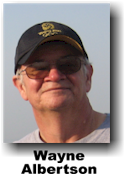 Transair – NAMC YS-11
Transair – NAMC YS-11
Probably the best part about being involved with the NetLetter is the feedback and comments that we receive from our readers. Thanks to your input, every story we write seems to lead to another story.
Our friend, Ken Pickford, who helps us with each NetLetter issue by volunteering his proof reading skills, sent in the following regarding the “aircraft restaurant” in Terry’s Trivia article from NL #1395.
“The aircraft type is a YS-11, built by a consortium of major Japanese companies, a 60-seat twin-turboprop powered by two Rolls-Royce Darts, 182 built through 1974. In service 1965. Winnipeg-based Transair operated 2 factory-delivered YS-11’s from 1966 until Transair's acquisition by Pacific Western Airlines in 1979.
Transair probably got a good deal on those aircraft. Sizable US regional carrier Piedmont Airlines (which merged with US Air in 1989) was the largest export customer with 20 plus a few acquired used. They used them on their short haul network along the east coast for a decade or more until the early 1980s.
Apart from the Mitsubishi Regional Jet (similar category to Embraer 170/190) which is still in the midst of its test program after several delays and now scheduled to enter service in 2020, the YS-11 remains the only airliner designed and built in Japan. As of 2017 only a few (single digits) were still in service with the Japanese military.” 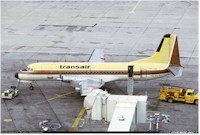
Terry adds the following:
"Among the employees at Transair’s Churchill base the year the YS-11 entered service was a young ticket agent named Peter Mansbridge.
Instead of purchasing B-737s (three of which were acquired later), Transair purchased two YS-11 turboprops in 1968. These replaced the company’s aging DC-4s and could be flown into small northern airports in a mixed passenger/cargo configuration. The YS-11s would remain in Transair’s fleet until 1979."
I had written about Transair in NL #1352 but neglected to mention these two aircraft built by the Nihon Aircraft Manufacturing Corporation. Registrations CF-TAK (pictured) and CF-TAM would finish their careers as N110PH and N111PH flying for Mid Pacific Air of Hawaii.
Mid Pacific Air ceased passenger operations in 1988 but continued cargo operations until 1995. Unfortunately, the fate of these two aircraft seems to be unknown.
Additional information and links:
NAMC YS-11 at Wikipedia
History and photos at Yesterday’s Airlines
History of Transair
Transair’s YS-11’s at Rzjets
Special thanks to Gary Vincent for permission to use this rare photograph of one of the two Transair YS-11's.
Sent to us by Bob Coates.
 A Boeing 777 jetliner was lumbering along at 800km/hour at 33000 feet when a cocky F-16 fighter jet flashed by at Mach 2.
A Boeing 777 jetliner was lumbering along at 800km/hour at 33000 feet when a cocky F-16 fighter jet flashed by at Mach 2.
The F-16 pilot decided to show off. On his state-of-the-art radio that is part of his state-of-the-art 3D & million dollar headset, the F-16 youngster told the 777 pilot, “Hey Captain, watch this!”
He promptly went into a barrel roll, followed by a steep, unimaginable, vertical climb. He then finished with a sonic boom as he broke the sound barrier, then screamed down at impossible G’s before levelling at almost sea level.
The F-16 pilot asked the 777 pilot what he thought of that?
The 777 pilot said, “That was truly impressive, but watch this!”
The 777 chugged along for about 5 minutes at a steady 800km/hour, and then the 777 pilot came back on the radio and said, “What did you think of that?”
Puzzled, the cocky F-16 pilot asked, “What the heck did you do?”
The 777 pilot chuckled and said, "I stood up, stretched my legs, walked to the back, used the toilet, then got a cup of coffee and a cinnamon roll and secured a date for the next 3 nights in a five-star hotel paid for by the company."
LESSON OF LIFE:
When you are young and foolish, speed and flash may seem like a good thing! When you get older and smarter, comfort and dullness is not such a bad thing!
It's called S.O.S. - Slower, Older, Smarter!
Dedicated to all my friends approaching, or who have already achieved, S.O.S...."Don't take life too seriously".
|
|
|
Hubbard Air Service 1919-1927.
In 1921 for no discernable reason, Hubbard lost the USPS contract to Alaska Airways. Ancel Eckmann who, in 1929, would be the first to fly Seattle-Juneau, flew American Airways’ Curtiss HS-21 flying boat on the service. The contract reverted back to Hubbard six months later. Upon Hubbard’s retirement in 1927, Herold Walker took over from Hubbard. He flew Hubbard’s B1 flying boat for Northwest Air Services Inc. until 1929. (Source: www.victoriaharbourhistory.com) |
|
The Farnborough International Airshow is a week-long, biennial event that combines a major trade exhibition for the aerospace and defence industries with a public airshow. This year's event was held July 16 to 19, 2018 at Farnborough Airport in Hampshire, United Kingdom. Below is a Youtube video showing "The BEST of Farnborough Airshow 2018". |
|
|
|
Located at Ottawa MacDonald Cartier International Airport. (Source: www.ofc.ca/OFCHistory) |
|
Executives from Air Transat say the company's rapid European summer expansion is part of a long-term strategy to remain competitive in transatlantic markets.
(Source: Flight International June 28, 2018) |
|
The Squadron Air Canada acknowledges that the weather at St. John's, Newfoundland is probably worse than anywhere else on the system. Sometimes, your airplanes don't get in.
McCool is President, CEO and Chief Pilot of Down East International Airlines, based at Moncton, New Brunswick, where the weather is no great shakes, either. But what sets DEI apart from other airlines is that it doesn't exist - except in Air Canada Captain Jack Desmarais' imagination and the back page of Canadian Aviation, Canada's National Aviation Magazine. And, not only are there DEI and McCool, there is Pete Braddock, T.l. (for Totally Inept) Jacobs, The Smarts, Cowboy McCloskey, Red Starr and Churchy Laflamme, "de bes' co-pilot of dem all." Stew Jane is a flight engineer, Mile-High Millie and Crazy lris take care of things in the cabin, and Phil Lister keeps the airplanes mechanically fit. |
|
"Ace McCool The hilarious collection from Down East International" by Jack Desmarais. available from Amazon. (Source: AC "Horizons' magazine issue January 1984) |


